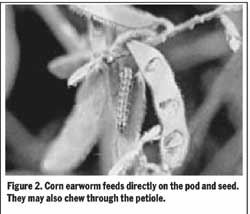Corn Earworm Could Take A Big Bite Out Of Your Soybeans
PRINCETON, KY.
Capture of corn earworm moths in the UK-IPM pheromone baited traps have increased significantly. This is rather typical as these late season moths are produced from caterpillars that have been feeding on our corn crop. The newly formed moths will mate and begin looking for a good place to lay their eggs. For most of the season one would expect them to lay their eggs on corn silks and other food sources. However, at this time of year, as corn matures and no fresh silks are available, the pods currently filling on our soybean crop could become home for many of these eggs.
Corn earworm, also called soybean podworm in Kentucky, can be a devastating pest due to two major factors. First, they feed directly on the pods and thus directly on the yield (figure 2). This is much more destructive than the mainly leaf feeding pests we see most of the season. Second, corn earworm feeds very little on the leaves, thus does not produce an easily observed symptom like the leaf feeders. You must look carefully at your plants for this pest, for your view of the crops from a distance will look no different whether or not the pest is present.
Infestation risk is increased in late planted soybeans, soybeans that do not produce a closed canopy and beans planed in wide rows, and beans planted near maturing corn fields.
Adults are buff to light green moths with a wingspan at rest of about ½” at rest. Eggs are white to pink and are laid singly. Larvae (worms) are small to 1 ½” in length when full grown. They are usually tan to pale green with several stripes down the back. However, color may be quite variable, with some individuals almost black.
In wide row beans sample using the “shake cloth” method, the economic threshold is an average of 2 worms per row-ft. If using a sweep net, especially in narrow rows, treatment is suggested if on average more than 9 larvae are captured in 25 sweeps. In both cases, take several reprehensive samples over the entire field, and average your counts.
Should insecticide application be necessary you may find a list of approved products in Ent- 13, Insecticide Recommendations for Soybean which may be found on the web at: http://pest.ca.uky.edu/EXT/Recs/welcomerecs.html, or from our County Extension office. Δ
DR. DOUG JOHNSON: Extension Professor of Entomology, University of Kentucky

Figure 2. Corn earworm feeds directly on the pod and seed. They may also chew through the petiole.